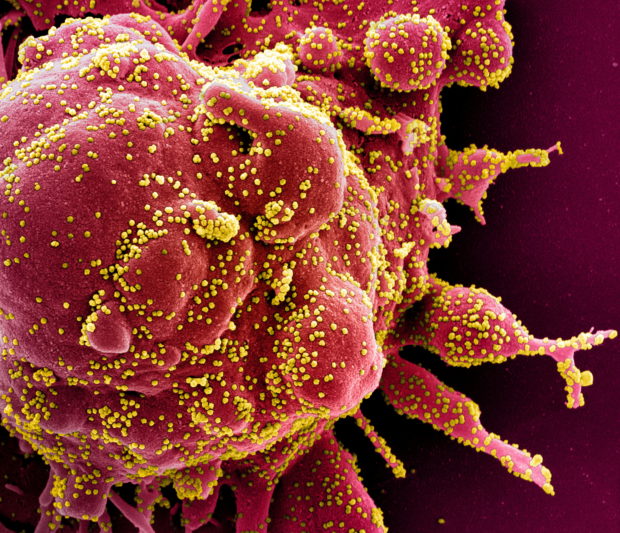
FILE PHOTO: Colorized scanning electron micrograph of an apoptotic cell (red) infected with SARS-COV-2 virus particles (yellow), also known as novel coronavirus, isolated from a patient sample. Image captured at the NIAID Integrated Research Facility (IRF) in Fort Detrick, Maryland. National Institute of Allergy and Infectious Diseases, NIH/Handout via REUTERS.
MANILA, Philippines — A databank on COVID-19 cases that is gender-sensitive, to help authorities assess gender-specific risks and roles amid the pandemic, is now up for use by local government units.
The National Research Council of the Philippines (NRCP), an attached agency of the Department of Science and Technology (DOST), said that the agency have created the COVID-19 Cases Monitor (CCMon) due to a need to “draw gender-specific insights based on COVID-19 epidemiological and socio-economic data.”
According to NRCP, men and women face different risks during the health crisis, as they play diverse roles in society and in the entire COVID-19 response.
“The health, social, and economic risk brought about by the COVID-19 disease have associated gender-specific aspects, such as the role of gender in the healthcare system, sex-dependent health vulnerabilities of individuals, and gender-related occupational hazards,” NRCP member-at-large Jomar Rabajante said during a program on Wednesday.
“The data visualizations can be filtered, such as, to show sex-disaggregated charts. This can be done by using the dropdown button or directly clicking the ‘male or female’ element of a specific chart,” he added.
Access to the CCMon can be obtained through https://skms.nrcp.dost.gov.ph/ccmon, which would require users to provide personal details before they could access the numbers. On the dashboard of the CCMon, a general data of the number of infections per area can be seen, with numbers provided by the Department of Health (DOH).
These are segregated per region, per province, and per city or municipality, with the area with the most COVID-19 cases on top.
On the sidebar, there are categories that would show the number of cases in 2020 and 2021, trends for a specific time period, and other patterns.
For example, active COVID-19 cases and expired cases for a specific time period would show differences in how males and females handle the disease, as the data drop from the DOH is segregated per gender or per age distribution.
NRCP’s site also shows which sectors are more vulnerable to infections and ready for alternative working setups.
“We also have studies on the risk of jobs based on the industrial sector. And there are many in the lower-income bracket which have moderate to high risk of exposure to COVID-19,” Rabajante, who is also the Professorial Chair for Teaching and Research in University of the Philippines – Los Baños, said.
“We also have information on the risk classification of jobs, and whether they are ready for the work from home mode,” he added. “We also have studies on the correlation between socioeconomic factors and COVID-19 cases, for example, the cumulative cases and population density.”
As the pandemic dragged on, several private firms like analytics group OCTA Research have processed official DOH COVID-19 numbers — which has provided officials a closer look at the trends with the pandemic.
NRCP clarified that their site’s numbers are a different appreciation of the DOH data drop, as it provides a deeper look into the demographics of COVID-19 patients, which would hopefully enable local governments to calibrate their response properly.
“So kung ano po ‘yong nasa OCTA na processed information, that’s good, wala pong problema do’n. Ito naman po kasi iba ‘yong audience nito, if you want to go with the details and check kung ‘yong mga reports ay ‘yon nga ‘yong nasa data, if there are people — kasi marami po tayong tao na gustong makita ‘yong detalye, hindi lang ‘yong processed (data) na nasa report,” Rabajante said.
(So whatever processed information in OCTA, that’s good, no problem with that. This one has a different audience, if you want to go to details and check what reports in the data, if there are people, because a lot of people wanted to see details, not only processed data in the report.)
“CCMon is for them […] Another one din po, katulad ng ginagawa namin sa LGU, let’s say may isang LGU na gusto no’ng summary na lang, ‘yong highlight, they partner with us and then we provide them the highlights na nasa processed form, let’s say a one-pager. This is not to compete with other groups, actually we complement each other,” he added.
(Like what we are doing in the LGU, let’s say there is an LGU that wants only the summary, the highlight…)
RELATED STORY:
The other surge: Mental health hotlines getting busier